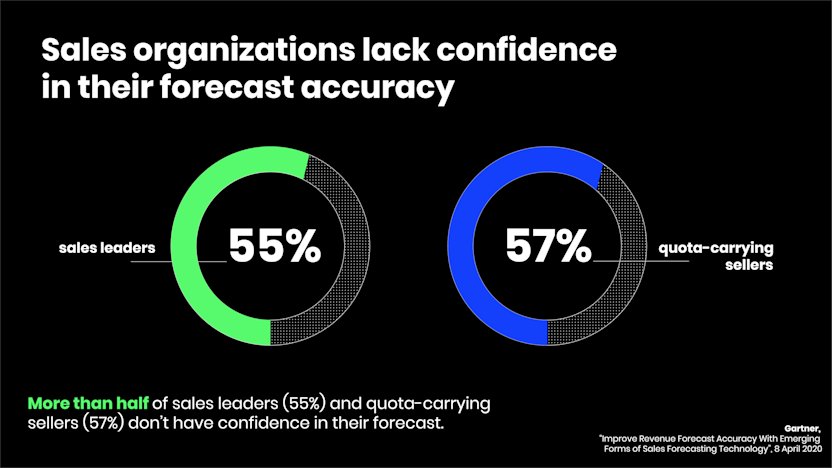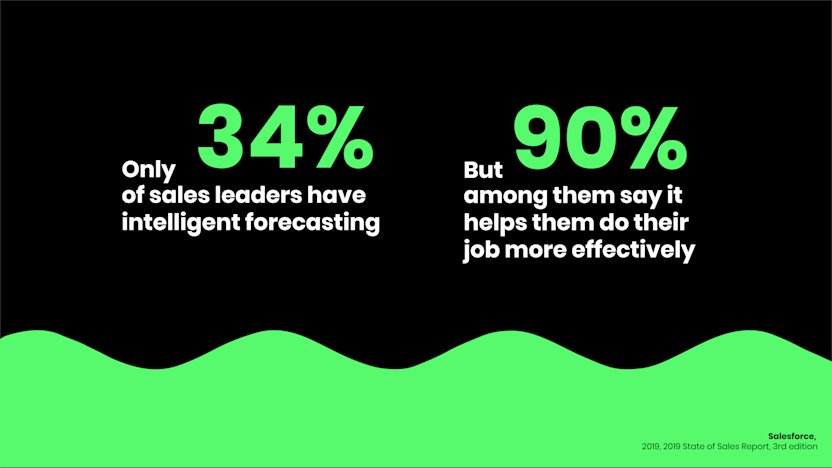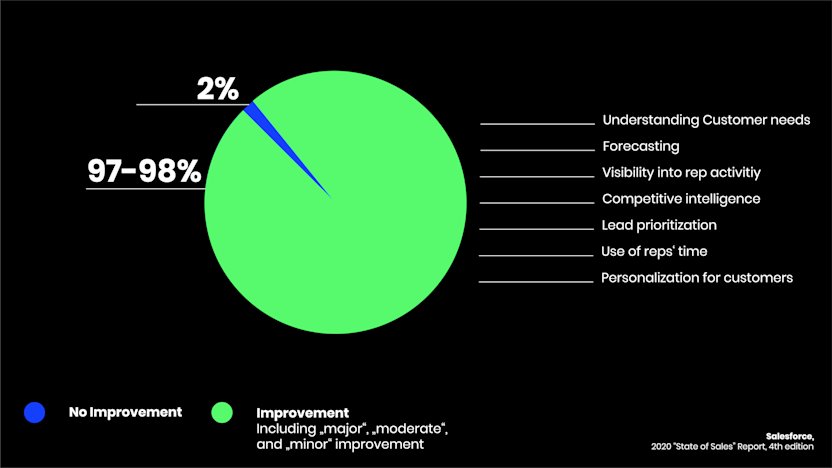
4 Ways AI Can Enable Smarter Sales Execution
Our sales execution needs to evolve. COVID-19 has made that clearer than ever. The pandemic disrupted 1:1 sales interactions and forced B2B sales further into the digital space. We build relationships and trust in video calls, prospect via email and Linkedin, and retrain field reps to sell from home. To get highly-educated, less predictable, and (even more) cost-conscious customers to buy, sales organizations need the right processes, digital skills, and technologies in place. And, if you believe Gartner’s predictions, AI and hyperautomation will play a pivotal role in it.

Calling on insights from their “The Future of Sales in 2025: A Gartner Trend Insight Report”, we’ll explore four ways in which AI and smart automation will usher in a new era of faster, smarter sales processes and operations.
1. Increasing sales productivity
Your one-on-one time is too valuable to waste retracing your rep’s steps or filling in gaps. Instead of spending hours interrogating sales reps and RVPs (“Did you send the email?” “Has the contract been sent?” “Who did you talk to?), trying to understand what’s going on in their deals, let technology do the work for you.
In combination with Process Mining, Machine Learning, and automation, Artificial Intelligence can help both sales reps and managers focus on the opportunities that really matter. While Process Mining can analyze all of your current opportunities and surface pipe gaps early at all levels (for example: engaged sweet-spot accounts that don’t have an opportunity yet), ML algorithms can prioritize the most promising opportunities (and the most “shaky” among those promising ones) based on prospect conversion trends and recent engagement. Knowing right away which opportunities need your highest attention, gives you time back to coach your reps — and your sales reps the confidence to meet their quota.
It’s important to note however, that the best AI tool can’t help you if your CRM hygiene is bad. Automated data entry can help eliminate the tedium of inputting contact and calendar information into a CRM (while also reducing entry errors), while AI-based recommendations can guide your sales reps to follow standard practices that will help keep your CRM data squeaky clean.
2. Coaching sales reps better (in and outside 1:1s)
Improving the relationship between the sales manager and the sales rep is the greatest point of leverage for sales productivity. But if sales managers have to repeat the “Sales 101” in their 1:1s (e.g. reminding sales reps of the critical steps in the process, CRM hygiene, etc.), there is not much time to make your team outperforming.
The bad news: Your existing CRM and Analytics software are great at assisting the top down monitoring of the sales outcome and organization, but they are simply not designed to guide your sales rep’s efforts. But hope is not lost. What may not be as obvious is that data (and AI) is the real key to better coaching and making managers better leaders. AI-driven software can help you surface coaching opportunities in your reps’ day-to-day – without lifting a finger. Get prescriptive recommendations for (e.g adding a partner to an opportunity that has been successful in the past) in real-time so you can course-correct the way you coach your rep, develop their strengths, and reinforce sales best practices on your team. It can also show you what top performers do differently and what good looks like for your team, so you can replicate it with other reps. This support doesn’t have to stop at your 1:1s. Advanced tools can also enhance your sales reps’ day to day work, by showing them how they’re performing against targets (f.e. if their pipeline quality is low) and peers.
The best tools offer intelligent recommendations on which opportunities they should prioritize (based on their impact on pipeline quality) and which actions will most likely move them to the next funnel stage. That can be strategizing with the champion on leadership buy-in, building credibility with the CIO by sending over a technical whitepaper, aligning with a partner, or connecting with a sales rep that has closed very similar deals with success. In other words: Your sales reps can be confident to crush their quota faster, while you can be sure you’re coaching them towards maximized performance.
3. Improving forecast accuracy
Data is the lifeblood of good sales management. For many CROs, however, rolling up the forecast is more art than science. You’re locating siloed data, having countless forecast calls, and yet, you’re still not any closer to hitting your number. How many times were you promised a number by your RVPs, but ended up with a different one? How many times were you left wondering where the difference between your sales manager’s and sales reps’ forecast comes from?
The problem is:Biases, guesswork, and business politics can all lead to wildly inaccurate forecasts and projections. Or, as Gartner puts it: “Traditional sales forecasts are often inaccurate, leading to missed sales targets and budget shortfalls.”

And even if you’re using a data-driven approach, your current tools don’t give you real-time visibility into each deal. By looking only at where your opportunities are today, they overlook the nuances of their individual journey: What are potential deal blockers? Has the close date been moved out? Are there upcoming meetings scheduled? Has an executive buyer been identified? What does their engagement look like? To start creating forecasts you can rely on, it’s essential to know where your forecast gaps come from – and that’s where AI and smart automation come in.

By blending qualitative forecasting with the power of technologies like process mining, AI, and smart automation, you can slice and dice your forecast at the most granular level. These tools enable sales teams to bring qualitative projections, objective data from a multitude of sources, and years of historical trend data together – helping them build up a true, complete view of which opportunities are most likely to close, and when.
4. Aligning sales and marketing (finally)
Organizations have been trying to bridge the gap between sales and marketing for years, if not decades now. In the worst case, your sales people struggle with bad inbound lead quality (“I’m wasting my time calling prospects that aren’t even remotely interested in what we do”), while marketers doubt your teams’ ability to sell (“Their job is so easy, we’re essentially handing them deals ready to close, and they still don’t close them.”). But the disconnect (and sometimes even open aversion) between Sales and Marketing not only stems from departmental silos, it’s rooted in their single-sided input.

Think about it: Instead of marketing campaigns churning out hundreds of leads of which only a quarter is likely close, shouldn’t campaigns get you leads that look a lot like previous leads that turned into deals? By using Process Mining and AI capabilities to map out each customer’s journey, sales teams can revert the feedback loop and help marketing understand which campaigns are resulting in the high-quality leads and highest volume of conversions.
With a single, shared view of customer data across marketing, sales, and service interactions, sales can also see the topics and types of marketing collateral that prospects are responding to at which stage of their journey – informing your sales team’s next best actions and giving your colleagues in marketing the intel needed to refine their campaigns.
And ultimately, knowing where your largest pipe gaps are can also help marketing leaders drive their campaigns dynamically (eg.by targeting campaigns towards highly engaged accounts that don’t have an opportunity) rather than aiming to meet static, pre-defined goals. In the best case, a fully integrated AI system that provides a true, 360-degree customer view helps people on both sides of the fence refine their campaigns, convert more leads, and close the departmental gap once and for all.
Outlook: Where the future of sales is going
While sales strategies have always evolved in response to customers’ changing needs, the current COVID-19 pandemic is pressing companies to understand (and design) their buyer journeys better than ever. Within the last couple of years, AI technology has proven to have tremendously improved sales on all levels, from sales’ rep productivity to customer insights to forecasting accuracy. In the 2020 Salesforce “State of Sales” report, sales leaders that have AI capabilities in place are shouting their success from the rooftops. To put it in numbers: 97 to 98% of sales ops and sales leaders believe AI has brought improvements to sales execution.

Thanks to this power to augment and improve sales performance, McKinsey analysts estimated in an 2019 Harvard Business Review article that AI can create $1.4 to $2.6 trillion of value in marketing and sales. While these figures give cause for optimism, the adoption of AI and smart automation in sales is still in its early days. According to the 2020 Salesforce report, most sales teams are still operating with little-to-no AI guidance (only 37% actually use AI). Therefore, it comes at no surprise that Gartner states: “Most B2B organizations lack the hyperautomation, artificial intelligence (AI) and digital scalability to deliver the multiexperience strategy that buyers seek.”
To maximize sales execution at scale, sales teams need to actually leverage the new capabilities available to build smarter processes that will shape their success for years to come. To get the complete picture and find out what else is in store for the future of sales, download Gartner’s Trend Insight Report, The Future of Sales in 2025.





